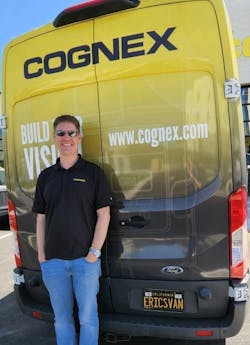Basic Considerations When Commissioning a Vision System
What are some of the key considerations when designing a vision system? What are the questions prospective customers should ask when appraising whether a vision application is feasible, or whether it will provide the right ROI out of adopting one system over another?
Machine Design asked two vision system experts to provide high-level insights into these questions during a webinar on machine vision tools and trends.
The panelists were: Eric Hershberger, principal applications engineer, Cognex, and David L. Dechow, owner/consultant, Machine Vision Source.
Below is an edited version of their responses. Download the full interview here.
Machine Design: What should a prospective customer ask you before deciding whether machine vision is a viable solution?
Eric Hershberger: The big thing I see a lot is that everybody thinks of machine vision after the fact. We’re always trying to fit small cameras in places that are not conducive to creating the right image.
We have all this fantastic technology but creating that great image with the light—the light together with the right placement will highlight what we’re trying to inspect, or to subtract the surface or do something else—seems always to be the afterthought. So, you’re always working with what you have. Some guys I work with—I always call them lighting ninjas—are just amazing at getting that light placement, but then going out to the line and trying to get that back again gets difficult.
READ MORE: Vision Systems: Basics of Machine Vision and Computer Vision
We’re always thinking about where the camera will be placed. We look at a lot of operator stations where operators are placing parts into a fixture, and we’re verifying that all the parts are in the right location, or that the clips are connected and that the cameras are not going to be in the way of the operators. Operators don’t like red flashy lights, or blue flashy lights, or green, or IR, which does different things with your imaging.
In the past, my sales team forgot to tell me about the skylight that’s directly above where we’re placing the camera. Skylights are great until the sun shines right to that [position] onto your inspection system. And if you haven’t filtered correctly, or blocked out some of the external lighting, you’re going to start to fail parts that are actually good, because you have external influences on that. Those are the big ones.
I, of course, always ask what kind of budget they are looking for? Personally, I always go as high resolution as possible. And sometimes that’s not necessary. Sometimes, we can go with some of the easier sensor solutions that are much cheaper than the higher-end applications.
In the end, do you have a good idea of what you’re looking for? Is it a defect? Do you have a bunch of samples that we can image and then show you what we do? That’s what I do the most. I have piles and piles of parts in my office right now because we’re running through evaluations. It’s usually described as a six-car wreck, with parts flying around everywhere. But what are you trying to find? Knowing that up front is the most important thing.
David L. Dechow: I’ll second that comment. Everything was spot on, but I'll second that comment. The one thing that I usually teach or communicate to the customer is, and the biggest mistake the customer makes is to come to me and say, “I want a machine vision system right here.” That’s not a good starting point.
The starting point, if you’re thinking about using machine vision, is to understand and communicate the needs of the application very specifically. It should not be, “Does this need to be inspected here or not? Do I need to guide a robot here?”
READ MORE: Deep Learning Algorithms Help Vision Inspection Systems See Better
Instead, ask: “What do you need to do?” Explain: “I need to make sure that this part doesn’t go past this past this point with a scratch on it, because that will not prevent me from adding value to a bad part.” Or, “I need to use something we don’t even have, such as a robot. I need to use something right here to move this part from point A to point B. Now, how can I do that technologically?”
The best advice I can ever give customers or people thinking about automation, is to not think about it in terms of what technology they are going to use, but to think about it in terms of what they need to do, and how it adds value to the process. And then we can start coming up with the machine vision solution.
Partners can start coming up with all sorts of great concepts in terms of how to how to add that value using technology. To be fair, sometimes we just say, “No, I can’t add value to that process.” The point is, start with what you need to do to add value to your process. And then dive into the technology that will deliver that [goal].
MD: Can you sum up your thoughts on bringing someone along as they learn about machine vision?
DD: The thought that’s always in the back of my mind is to learn how to use the technology and use it correctly. Understand that it is there to provide value and to serve the process. Many people in today’s industrial environment still get scared of machine vision, or maybe a little bit loath to implement machine vision. With all the tools we have now, the deep learning and even into the algorithmic tools we’ve had for a long time, machine vision is more efficient, cost-effective and reliable than ever.
If you don’t have the skill set to do it yourself, seek out someone who does. But don’t shy away from machine vision as a technology, because that's really going to be part of the future in machine vision, enabling and robotics, enabling automation. So, a final word is, just use it. You're going to find that it will help the manufacturing process.
EH: In the past, we’ve seen a lot of new customers who had never installed cameras before. They tend to choose the hardest projects to start with and then have a very difficult time with it. It’s a complicated project that probably doesn’t have great specifications, is complex to support, and in the end, they end up failing. Then, with any subsequent project, that system didn't work. So, I always start with the simple successes and then try to work up from there.
But there are so many great resources now. Back when I started, it was kind of, toss a camera out there, toss a light and see what you can come up with. I’m a big fan of some of the certifications that are out there now, the classes that you can take from industry leaders and really get a good idea of some of the basics just within a week. And we’re starting to see a lot more classes popping up at universities with different machine vision concepts. And there are all kinds of AI research, of course.
So, the fundamentals. Start playing with cameras and lighting, and just go for it. It is such a great time to do it, too. There are so many fun things to learn and enjoy with machine vision.
READ MORE: The Vision of Sustainable Agriculture: Laser-Focused on a Weed-Free Farm
About the Author

Rehana Begg
Editor-in-Chief, Machine Design
As Machine Design’s content lead, Rehana Begg is tasked with elevating the voice of the design and multi-disciplinary engineer in the face of digital transformation and engineering innovation. Begg has more than 24 years of editorial experience and has spent the past decade in the trenches of industrial manufacturing, focusing on new technologies, manufacturing innovation and business. Her B2B career has taken her from corporate boardrooms to plant floors and underground mining stopes, covering everything from automation & IIoT, robotics, mechanical design and additive manufacturing to plant operations, maintenance, reliability and continuous improvement. Begg holds an MBA, a Master of Journalism degree, and a BA (Hons.) in Political Science. She is committed to lifelong learning and feeds her passion for innovation in publishing, transparent science and clear communication by attending relevant conferences and seminars/workshops.
Follow Rehana Begg via the following social media handles:
X: @rehanabegg
LinkedIn: @rehanabegg and @MachineDesign


